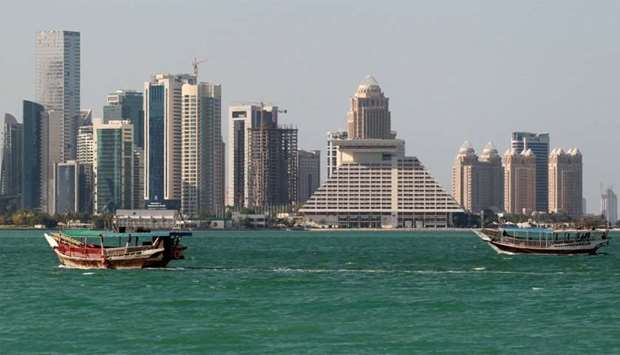Qatar’s merchandise trade balance has been estimated to rise to $55bn by 2025 from $42.2bn this year, according to researcher FocusEconomics.
The country’s merchandise exports are estimated to total $91.9bn, while imports $36.9bn in 2025, FocusEconomics said in its latest consensus forecast.
Qatar’s GDP, FocusEconomics noted, will scale up to $203bn in 2025 from $171bn this year. Next year’s forecast is $181bn, followed by $187bn (2023) and $195bn (2024).
GDP per capita, FocusEconomics said, may reach $71,529 in 2025 from $61,075 this year. Next year, it is forecast at $64,246, followed by $66,314 (2023) and $68,928 (2024).
The country’s fiscal balance (as a percentage of GDP) has been forecast at 3.8 in 2025 from 3.9 this year, 4.8 (2022), 3.7 (2023) and 3.8 (2024).
Qatar’s public debt (as a percentage of GDP), FocusEconomics in its consensus forecast said, will fall to 50.3 in 2025, from 62.5 (2021), 57.8 (2022), 55.2 (2023) and 52.7 (2024).
Inflation based on consumer price index (CPI) has been forecast to range between 1.6 and 1.8 until 2025.
According to FocusEconomics, the economy grew 4% year-on-year in Q2, “rebounding firmly” from the first quarter’s 2.5% contraction.
“The upturn was spearheaded by a solid expansion in the non-energy sector, although the result was flattered by a base effect and underlying momentum was likely constrained by tougher Covid-19 restrictions early in the quarter,” the researcher said.
Turning to the third quarter (Q3), conditions seemed to improve. The PMI averaged markedly higher in the first two months of the quarter compared to the second quarter (Q2).
“Moreover, higher crude oil and natural gas prices globally should have boosted the country’s all important energy sector, in turn buttressing overall economic activity,” FocusEconomics noted.
The country’s GDP, according to the researcher “should rebound” this year, on the back of sturdier foreign demand and looser restrictions at home propping up domestic activity.
Next year, growth is seen “picking up steam”, supported by a “healthier” energy sector and “accelerating” private spending.
A potential snapback of restrictions due to new Covid-19 variants remains a key risk to the outlook this year and next.
FocusEconomics panelists see a 2.7% rise in GDP in 2021 and 3.9% growth in 2022, which is unchanged from last month’s forecast.
Inflation ticked down to 3% in August, from a five-year high of 3.1% in July. Price pressures are expected to remain moderate for the rest of this year and into 2022.
FocusEconomics panellists see inflation averaging 1.6% in 2021 and 2.4% in 2022, which is unchanged from last month’s forecast.
The country’s merchandise exports are estimated to total $91.9bn, while imports $36.9bn in 2025, FocusEconomics said in its latest consensus forecast.
Qatar’s GDP, FocusEconomics noted, will scale up to $203bn in 2025 from $171bn this year. Next year’s forecast is $181bn, followed by $187bn (2023) and $195bn (2024).
GDP per capita, FocusEconomics said, may reach $71,529 in 2025 from $61,075 this year. Next year, it is forecast at $64,246, followed by $66,314 (2023) and $68,928 (2024).
The country’s fiscal balance (as a percentage of GDP) has been forecast at 3.8 in 2025 from 3.9 this year, 4.8 (2022), 3.7 (2023) and 3.8 (2024).
Qatar’s public debt (as a percentage of GDP), FocusEconomics in its consensus forecast said, will fall to 50.3 in 2025, from 62.5 (2021), 57.8 (2022), 55.2 (2023) and 52.7 (2024).
Inflation based on consumer price index (CPI) has been forecast to range between 1.6 and 1.8 until 2025.
According to FocusEconomics, the economy grew 4% year-on-year in Q2, “rebounding firmly” from the first quarter’s 2.5% contraction.
“The upturn was spearheaded by a solid expansion in the non-energy sector, although the result was flattered by a base effect and underlying momentum was likely constrained by tougher Covid-19 restrictions early in the quarter,” the researcher said.
Turning to the third quarter (Q3), conditions seemed to improve. The PMI averaged markedly higher in the first two months of the quarter compared to the second quarter (Q2).
“Moreover, higher crude oil and natural gas prices globally should have boosted the country’s all important energy sector, in turn buttressing overall economic activity,” FocusEconomics noted.
The country’s GDP, according to the researcher “should rebound” this year, on the back of sturdier foreign demand and looser restrictions at home propping up domestic activity.
Next year, growth is seen “picking up steam”, supported by a “healthier” energy sector and “accelerating” private spending.
A potential snapback of restrictions due to new Covid-19 variants remains a key risk to the outlook this year and next.
FocusEconomics panelists see a 2.7% rise in GDP in 2021 and 3.9% growth in 2022, which is unchanged from last month’s forecast.
Inflation ticked down to 3% in August, from a five-year high of 3.1% in July. Price pressures are expected to remain moderate for the rest of this year and into 2022.
FocusEconomics panellists see inflation averaging 1.6% in 2021 and 2.4% in 2022, which is unchanged from last month’s forecast.


